
The Nathan Lester House is a historic house museum at 153 Vinegar Hill Road in the Gales Ferry section of Ledyard, Connecticut. Built in 1793, it is a well-preserved example of an unpretentious late 18th-century farmhouse, and one of the few houses of that age left in the town. It is located on over 156 acres (63 ha) of land, now owned by the town, which serves as a park and conservation land with trails.

The Church Farm is a historic former farm at 396 Mansfield Road in Ashford, Connecticut. Built in 1821, the main house is a remarkably sophisticated example of Federal period architecture in a rural setting. The property was listed on the National Register of Historic Places in 1988. It is now the Church Center of Eastern Connecticut State University.

The Benjamin Aldrich Homestead is a historic homestead east of the terminus of Aldrich Road, slightly east of Piper Hill in Colebrook, New Hampshire. Developed beginning in 1846, it is the oldest surviving farm property in the town. Its farmstead includes the original 1846 house and barns of the period. It was listed on the National Register of Historic Places in 2003, and the New Hampshire State Register of Historic Places in 2002.

The George and Mary Pine Smith House is a private house located at 3704 Sheldon Road, near Sheldon in Canton Township, Michigan. It was listed on the National Register of Historic Places in 2000.

The Timothy Lester Farmstead, also known as the Garrison House, is a historic farmstead at Crary and Browning Roads in Griswold, Connecticut. Set on 43 acres (17 ha) of land, the farmstead retains the look and feel of an 18th-century farm property, with a c. 1741 farmhouse, and farm outbuildings dating from the 18th to 20th centuries. The property was listed on the National Register of Historic Places on December 4, 1998.

The Franklin Harris Farmstead is a historic farm complex located outside the village of Salem in Columbiana County, Ohio, United States. Once home to a prominent former soldier, the farmstead includes a high-style farmhouse from the 1890s, and it has been named a historic site.

The Brewster Homestead is a historic house at 306 Preston Road in Griswold, Connecticut. Built about 1740, it is one of the oldest surviving buildings in the town. The house was owned by six generations of the Brewster family, and originally was the centerpiece of a farmstead of 250 acres (100 ha). The house was listed on the National Register of Historic Places in 2000 by Ron and Kate Bauer.
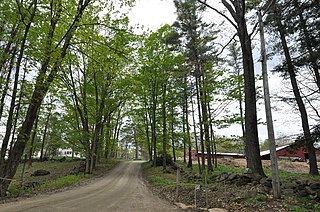
The John Adams Homestead/Wellscroft is a historic farmstead off West Sunset Hill Road in Harrisville, New Hampshire. The oldest portion of the farm's main house is a 1+1⁄2-story wood-frame structure built in the 1770s. It is one of the least-altered examples of early Cape style architecture in Harrisville, lacking typical alterations such as the additions of dormers and changes to the window sizes, locations, and shapes. The farmstead, including outbuildings and an area of roughly 2 acres (0.81 ha) distinct from the larger farm property, was listed on the National Register of Historic Places.

The Lawrence Farm is a historic farm at 9 Lawrence Road in Troy, New Hampshire. Established in the early 19th century, the property has been in continuous ownership by the same family since then. Its farmstead, including a c. 1806 farmhouse, exemplifies the changing trends in domestic agricultural practices of the 19th and 20th centuries. The farm was listed on the National Register of Historic Places in 2000.

Elm Farm, alsk known as the Sargent Farm, is a historic farm property at 599 Main Street in Danville, New Hampshire. Established about 1835, it has been in agricultural use since then, with many of its owners also engaged in small commercial or industrial pursuits on the side. The main farmhouse is one of the town's best examples of Gothic Revival architecture. The property was listed on the National Register of Historic Places in 1988.
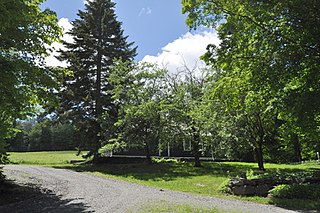
The Crows Nest is a historic farmstead property at 35 Sturgis Drive in Wilmington, Vermont. The 75-acre (30 ha) property includes rolling woods and a hay meadow, and a small cluster of farm outbuildings near the main house, a c. 1803 Cape style building. The property typifies early Vermont farmsteads, and is now protected by a preservation easement. It was listed on the National Register of Historic Places in 1998.

The Whitney Farm is a historic farm property at 215 Whitneyville Road in Appleton, Maine. Encompassing more than 200 acres (81 ha) of land in Appleton and Searsmont, the farm exemplifies the evolutionary history of farm properties in the Mid Coast region, with a variety of outbuildings reflective of changing trends in agriculture, and a c. 1825 farmstead that was not fitted for electricity or indoor plumbing until 2008. The property was listed on the National Register of Historic Places in 2015.
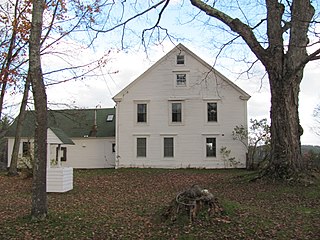
The Zachariah Spaulding Farm is a historic farmstead on South Hill Road in Ludlow, Vermont. With a history dating back to 1798, it is a well-preserved example of diversified 19th-century farmstead, made further distinctive by the remains of a sauna, the product of ownership by two Finnish families in the 20th century. It was listed on the National Register of Historic Places in 1993.

The John Hamilton Farmstead is a historic farm property on Vermont Route 125 in Bridport, Vermont. It was established in 1795 by John Hamilton, and includes one of Bridport's oldest surviving houses. It was listed on the National Register of Historic Places in 1993.
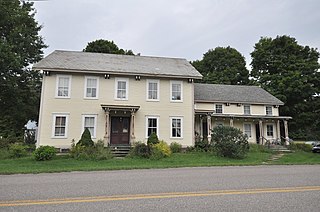
The Martin M. Bates Farmstead is a historic farm property on Huntington Road in Richmond, Vermont. Farmed since the 1790s, the property is now a well-preserved example of a mid-19th century dairy farm, with a fine Italianate farmhouse. The property was listed on the National Register of Historic Places in 1991.
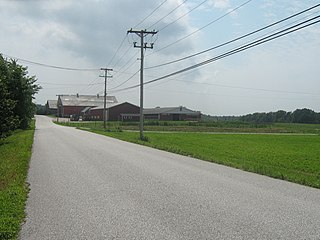
The Ballard Farm is a historic farm property on Ballard Road in Georgia, Vermont. At the time of its listing on the National Register of Historic Places in 1993, it had been under cultivation by members of the Ballard family for more than 200 years, having been established in 1788 by a sale from Ira Allen to Joseph Ballard.

The West View Farm is a historic farm property on Hastings Road in Waterford, Vermont. The farm is unique for its distinctive round barn, built in 1903 to a design by St. Johnsbury architect Lambert Packard, and surviving 19th-century corn crib and smokehouse. The property was listed on the National Register of Historic Places in 1995. It includes a round barn.

The Woodbridge Farmstead is a historic house at 495 Middle Turnpike East in Manchester, Connecticut. Built about 1835, it is a well-preserved example of a Greek Revival farmhouse, with a history of ownership by a single family extending over more than 150 years. It was listed on the National Register of Historic Places in 1999.

The Chatfield Farmstead is a historic farmstead at 265 Seymour Road in Woodbridge, Connecticut. Developed in the late 19th century, it includes a particularly well preserved period barn. The property was listed on the National Register of Historic Places in 2010. It is currently operated as the Bladen Valley Farm.
The Luce Farm is a historic farm property at 170 Luce Drive in Stockbridge, Vermont. The farm was established in the late 18th century, and is a well-preserved example of a rural agriculturally diversified farm property. It was listed on the National Register of Historic Places in 2021.





















